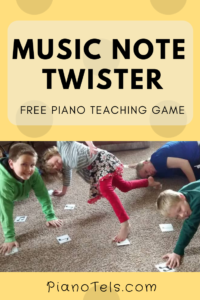Looking for some fun and creative games and activities for your music classroom? These games are fun, easy to explain and execute, and great at teaching and reinforcing musical concepts! You will find most of the materials for the games in free, downloadable links, or items you will probably already have.
1. Music Note Twister:
This game is designed to review note & rest names and values.
Spread out the music note and rest cards (available if you click on the Music Note Twister link) all over the classroom floor face up. Roll a die. Whatever number is rolled, they need to touch notes on the floor to add up to that number. For example, if a 2 is rolled, they can step on a half note, or 2 quarter notes, or 1 quarter note and 2 eighth notes, etc.
Watch out, because as they touch the notes, they will find themselves losing their balance as they work around the notes and around each other! It’s hard to play this game and not end up on the floor laughing.
2. Musical Note Spoons:
This game is designed to help build sight reading skills by reviewing notes on the staff and learning to quickly correlate notes with each other (steps, skips, etc.). A player wins when he/she has consecutive notes that either ascend or descend.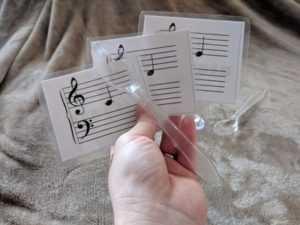
This is a fast paced game! Don’t let it stress your music students out…the more they play, the better they will get at it! It takes skill to look at a note and be able to figure out it’s correlation with the other notes in your hand!
Player #1 picks up a card from the pile, decides if he/she wants to keep that card, then places down a card to the next player so that player #1 maintains 3 cards in their hand. Player #2 repeats the process.
The last player makes a “discard” pile that can then be used again if needs be. Once a player has 3 consecutive cards, they can grab a spoon. Whoever is not able to grab a spoon before the other players is “out”.
3. Word Search with Music Notes:
See how quickly your music students can put together a word once you call it out! Played alone or with a group, this game really makes sure you know the names of the notes — and be quick about it, too!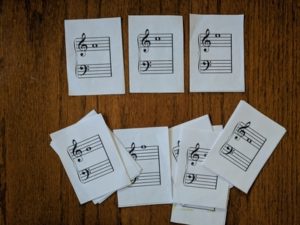
Begin by mixing up the treble clef. Call out a word (go to Word Search with Music Notes for examples of words you can use), and see how fast they can put together the word using the note cards to create the word. For example, if the word is ACE, then they must find an A, a C, and and E. They put them in the right order and they are done! First one to get it wins that round.
Do the same with the bass clef. You can use the same word, or mix it up and use a different word. For other variations of this game, visit Word Search with Music Notes.
4. War! Music Note Card Game
This game has got to be one of my students all time favorites! I first found this idea off of teachpianotoday.com. We played it once and 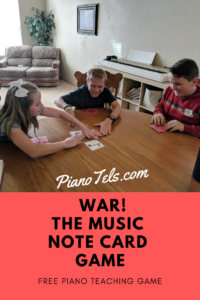 my students were hooked. They now ask to play this as often as I will let them! Be careful — don’t teach them this game before you are good and ready to have some serious fun!
my students were hooked. They now ask to play this as often as I will let them! Be careful — don’t teach them this game before you are good and ready to have some serious fun!
Evenly divide the cards (available on War! Music Note Card Game) among the group of students. Each player keeps their stack of cards face down. Each student takes a turn flipping over a card. The player that plays the note or rest of the highest value, takes all the cards and adds it to their own stack of cards.
The objective is to get all the cards in your hand.
A note “trumps” a rest. So if a whole note and a whole rest come up against each other, than the note wins the round.
If the highest value is tied with another player, then there is WAR! Each player that tied, flips over a card until they are able to beat out the other player and win all the cards in that round.
This game sure gets them excited as they quickly realize that whole notes and rests are highly valued! Talk about a quick and easy way to get the students to learn and remember the note & rest names and values quickly!
5. Musical Headbanz
Musical Headbanz really tests your knowledge! Students get to interact with one another in your music classroom as they work together to help each other figure out what is on their head. Yep, this is the game to really help students get it in (or at least on) their head! 
Each player helps the other ones figure out the word or symbol on their forehead by giving them hints or clues. #1 Rule is to not say the word on the card. It can be described or demonstrated, but not said.
This can be a quick moving game as you replace cards as soon as they figure out the word on their forehead. Finish off the deck of cards and the game is complete!
I love how this game helps them learn new ways of describing terms. It exposes them to terms or symbols they may not use very often as well. It gives them an opportunity to work together as a team and to think of new ways to describe a musical term or concept.
6. Musical Spit-It-Out!
Musical Spit-It-Out! is one of the best, last minute games to pull together for a music classroom. It only takes a couple minutes to play and takes absolutely no  preparation beforehand. This is a great way to get the brain thinking!
preparation beforehand. This is a great way to get the brain thinking!
Students are given a musical topic. A timer is set for 1 minute. Within that one minute, they can write as many words under that category as possible.
The student with the most words wins!
Category examples can include:
- Dynamics
- Tempos
- Musical symbols
- Any musical term
- Major & Minor Chords
- Any chord
- Chord progressions
- Key signatures
7. Musical Don’t Eat Pete!
Don’t eat Pete! has also got to be one of the best go-to games. It is super fast to pull together, will work with about a million different  subjects, and students love it.
subjects, and students love it.
Divide up the white board into even squares. I like to do anywhere from 9 – 16 squares. Write in whatever musical concepts you would like to review into the boxes. It could be musical terms, rhythms you want them to clap out, dynamics, articulations, or whatever it is you want to review.
Place little treats (or magnets or other objects) in each square. The teacher, or a student, chooses one square that will be “Pete” and keeps that a secret from the person who is it.
Each student takes a turn choosing a square. They must identify, define, or clap out the rhythm that is in the square before they can take the treat and eat it. If they can’t identify what is in the square, the treat stays there and they must choose another square.
If one of the students choose “Pete” then the teacher (and whoever else knows) yells out, “Don’t Eat Pete!” and that person’s turn is over.
The awesome thing about this is that you can use the same squares, or switch them up and put in new concepts and continue playing. This is a super versatile game, so play it how it works best for you!
This is also a good time to assess areas that you need to work on or review a little more in depth. It’s a quick assessment tool and I always keep notes of those things we should spend time on later.
8. Whack-a-Time-Signature
Whack-a-Time-Signature is a fun teaching game for the music classroom and it helps students listen to and review time signatures. Not only does it help the students count out a measure and keep the beat, it requires team coordination!
Not only does it help the students count out a measure and keep the beat, it requires team coordination!
Choose a time signature. Begin listening to the music. For links to songs with typical time signatures, click on Whack-a-Time-Signature. As a teacher, I start counting out each measure until it seems that the kids have it figured out.
For beginner students, I have them count out loud for this game. For other students, I have them count in their heads to make it a little more challenging.
At the signal of the teacher, one student stands up for one whole measure, then sits down while another student stands up for the next measure. The students continue to take turns standing up for each measure with only one student standing at a time.
The reason this game is called Whack-a-Time-Signature, because the students standing up and sitting down are similar to the game Whack-a-Mole.
For a large class, the students have to coordinate on their own without any prompting as to who goes next. This is so fun to see if they can only have one person standing, but never miss a measure too! This takes a lot of coordination AND practice! But it’s definitely possible as we have done it in our musical classroom of about 30 students!
Switch songs and choose other time signatures. You can continue to work through all the time signatures you want.
9. Dynamic Pictionary
Dynamic Pictionary is exactly what it sounds like — it is a dynamic version of Pictionary! It is dynamic because it reviews dynamic  terms and symbols, and it is dynamic because the students really get excited about it! This game causes the students to think quick on their feet and to identify dynamic symbols.
terms and symbols, and it is dynamic because the students really get excited about it! This game causes the students to think quick on their feet and to identify dynamic symbols.
One person from each team comes up and is shown the same dynamic card. They can immediately return to their team and draw the symbol on the white board. The first team to guess what is drawn on the white board receives a point.
Play continues until all the cards have been drawn.
The team with the most points wins!
This is a simple game, but allows the students to think quickly. It is a good way to assess how well they know their dynamic markings! Sometimes I throw the same cards in again, just to reinforce some dynamic markings that they may not have known as well previously.
10. Interval Explosion
Being able to identify intervals immediately is an essential skill for sight reading. That’s why I like to do all I can to get my students to identify an interval by sight as quickly as possible. This game helps do just that!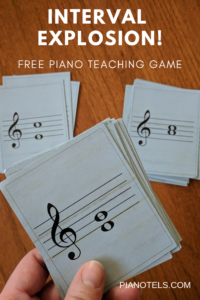
This game is also a helpful assessment tool for me to see just what they know, and don’t know, about intervals.
Mix up the interval cards, face down. Then the player has to sort the interval cards in odd and even intervals before the timer “explodes”! If they can’t sort it out before the timer explodes, then you get to give them a spray in the face.
Of course, the “explosion” is completely optional and you will have to decide if that will be fun, or not so fun for your student.
The reason I like my students sorting intervals into odd and even intervals is because this helps them to identify the pattern of odd and even intervals: that odd intervals will have both notes be the same (they will both land on spaces or both land on lines). The even intervals will always be different (one note will land on a line, one on a space).
Begin with 30 seconds time explosions, then see if they can do it in 25 seconds or less!
Once they have that mastered, then you can have them sort the cards into 1st, 2nd, 3rd, 4th, 5th, 6th, 7th, and octaves. Do this before the timer explodes…or else!
11. Tempo Musical Chairs
This active game really helps to get the steady beat and rhythm in the students head as they walk to the beat of the tempo. This is a game of lots of fun and laughter!
One student rolls the die to determine which tempo we will be using for this round. Click on Tempo Musical Chairs for a downloadable tempo chart. Set the metronome, or the song, to the chosen tempo.
Set up chairs in a tight circle, facing out. Set up one less chair than the amount of students you have. The students must walk around a circle of chairs at the beat of the tempo. Randomly stop the song and the students must sit down. Since there is one less chair than people, one student won’t have a chair and he/she will be “out”.
Keep playing the game always choosing a new tempo and taking away a chair every round so that there is always one less chair than players. Enjoy the laughter and the fun!
12. “Scale”-ing the Marshland
Learning the scales in music theory can seem daunting…but Scale-ing the Marshland is a game that will naturally reinforce the scales as they make their way safely across the marsh with the help of their scales!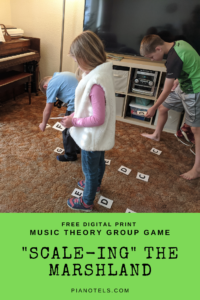
Each player needs to build a scale to cross the marshland and get to the other side.
Each player takes a set of cards and when the teacher calls out the key signature, each player needs to set out the right cards to make a complete scale. The sharps and flats can be placed next to the cards if need be.
Once they have the scale down on the ground, then they can cross the marshland and make it safely to that side. The first player to do this, wins!
For more details, or a few other variation, click on “Scale”-ing the Marshland.
13. Musical Pit
This is based off of the popular game of Pit – an exciting, fast paced, competitive game that just about anybody can play! 
To help build sight reading skills by reviewing notes on the staff and learning to quickly recognize note names. A player wins when he/she has a full set (6 cards) of a note.
With the ring of a bell, the game begins! Each player is wanting to get a full set to win the round. In order to do so, players can “bid” off their cards and switch them with other players who are bidding. You can only bid same card sets. So, if I have 3 of the A set, 2 of the B set, and 1 of the C set, I can bid two of the B set and call out, “Two! Two! Two!” with switch my cards with any other bidder who is bidding off two cards. I then evaluate which new cards I have and which cards I may still need to get. You continue to bid until you have the whole set. Since others are likely to be getting a set just as quickly as you, you will want to be the first one to declare yourself the winner by hitting the bell or grabbing the selected item.
This is a fun, fast paced game, and it can get a little noisy too! Click on Musical Pit for more details and for access to the game cards.
14. Musical CODENAMES
Musical CODENAMES is a game my students frequently request. They love the challenge of the game, and I love that they are making  connections with musical terms and concepts! It’s an awesome combination that you can’t quite get in any other game out there.
connections with musical terms and concepts! It’s an awesome combination that you can’t quite get in any other game out there.
This is a musical spin off of the popular game Codenames. I like that version, but of course this has become a favorite for me, too. Click on Musical CODENAMES for a full explanation with pictures and downloadable cards.
This is such a fun game and it really causes you to think! It’s a great way to make sure you know all of these terms!
15. Where is Thumbkin (Finger 1)?
Created for grades pre k-2nd, this activity helps learn finger numbers for the piano and strengthens finger muscles and independence. The hands also develop the curved finger hand position used in playing the piano.
Using a small ball, the students place their hands on the ball and sing along to the song, Where is Thumbkin? Using finger numbers instead of naming the fingers. For an example of how to do this, visit Where is Thumbkin (Finger 1)?
16. Go, Chord, Go!
Go, Chord, Go! Is a game that I love to play with my students because it causes them to review and know the basic major and minor  chords by sight without them even realizing it! This game is a variation of Go, Fish!
chords by sight without them even realizing it! This game is a variation of Go, Fish!
The students are trying to get as many matches as possible. The students follow the same rules as “Go, Fish”. The students take turns. The first player asks any other player for a card that matches a card in their hand.
For instance, if I have the C chord chart in my hand, then I can ask player #2 if they have the “C chord”. They can look in their hands to see if they have the C chord. If they do, then they must give that card to me.
If they don’t have the C chord, then they say, “Go! Chord, Go!” I then draw a card from the draw pile. Any time someone gets a match, they lay their match on the table and then they can go again.
The play continues until all the cards are used!
I love how this game causes them to review all those chords and get to know them by sight. They are constantly looking at their cards in their hands and trying to figure out which chords they are holding in their hands. It gives them a lot of repetition.
For downloadable cards, go to Go, Chord, Go!
17. Major and Minor Chords Snakes and Ladders
Chords Snakes and Ladders is a fun teaching piano game for reviewing chords. The game play is just like the original Snakes and  Ladders games, but this time with a musical twist. The cards are chords and they must be able to identify the chord before they can advance on the game board. But watch out — there are snakes and ladders that may change your course! For downloadable cards to this game, go to Major and Minor Chords Snakes and Ladders.
Ladders games, but this time with a musical twist. The cards are chords and they must be able to identify the chord before they can advance on the game board. But watch out — there are snakes and ladders that may change your course! For downloadable cards to this game, go to Major and Minor Chords Snakes and Ladders.
The students are trying to get to the end of the game board first!
The players draw a chord. They can move their marker, or game piece up to the place on the game board. For example, if they draw the C chord image, then they need to be able to identify the chord, then move their game piece up to the C chord on the game board.
If the player’s game piece of marker lands at the bottom rung of a ladder, they can take the shortcut and climb the ladder! The player ends up at the top of the ladder.
If the player’s game piece lands on the head of a snake, they must slide down the snake and land at the very tail end of the snake. They are set back quite a ways when this happens.
If a player lands anywhere in between the head or tail of a snake or the beginning or end of a ladder, then nothing happens.
The player who makes it past the last square wins!
18. The Interval Game of Sorry
This is one of my all time favorite ways of helping the students to recognize intervals by sight. This has a lot to do with repetition, but  the students hardly even recognize that they are learning the intervals by repetition because they are consumed in the game.
the students hardly even recognize that they are learning the intervals by repetition because they are consumed in the game.
The students draw an interval card and play across the game board. All player’s game pieces begin in the “Start” bubble.
The rules are as follows. The interval that they draw from the draw pile allows them to:
- 1st, 3rd, 5th — get out of Start
- 2nd – go 2 and go again
- 4th – go backwards four
- 6th – switch opponents
- 7th – split between 2 pawns
- 8va – go from anywhere on the game board directly to home (the kids love drawing on octave for this reason)
In the game of Sorry, every time you land on a triangle, you can “slide” down to the end of the line. The stipulation to that is that you can’t slide on your own color — only on everyone else’s. If you happen to bump out another player while they are on that slide, then they must go back to “Start”.
Anytime you land on another player, they must go back to “Start”.
The player who can get all of their game pieces into the “Home” position first, is the winner!
Because this game can get lengthy, I usually only have the students play with 2-3 game pieces. This helps make it not take up quite as much time.
The students love this game and they catch on quickly to the intervals and hope for certain intervals to come up…meaning that they end up loving intervals and are excited to see and identify them in their music after playing a game like this.
19. Ping Pong Toss
A fantastic game for a little more activity and review. The students learn the note & rest names and values quickly as they try and get  as many points as possible. Click on Ping Pong Toss for more details.
as many points as possible. Click on Ping Pong Toss for more details.
20. Music Note Jenga
The students can’t help but get themselves wrapped up in this game as they try and keep the stack from toppling! They don’t even realize they are reviewing note & rest names and values as they play. Click on Music Note Jenga for more details.
Keep the music note cards face down on the table. Set the Jenga game up so that it is stacked up neat — exactly like it is shown in the original game.
The rules are similar to the normal game of Jenga. But with one musical twist: the person draws a music card to determine the next move. Whatever note or rest they draw, they must pull that many (according to the note or rest value) blocks from the Jenga stack!
For example, if a whole note is drawn, then 4 blocks must be drawn from the stack without making the stack fall over! Each block that is drawn should be placed carefully on the top of the stack to increase difficulty.
You can imagine that this game moves quickly since you can draw up to four blocks at once!
If the stack falls over while you are drawing out a block — you lose!
21. Forte, Piano!
Students hide an object in the room. Another student tries to find the object by the hints of the students. The students hold up various dynamic signs, louder means they are getting closer, piano means they are getting further away.
Tel loves her life as a piano player, a piano teacher, and a mom. Amid piano blogging, piano teaching, and piano playing, she loves a chance to fit in a good exercise class, volunteer at her kids’ school and at her church, and go on long dates with her husband. Full bio at About Tel.

